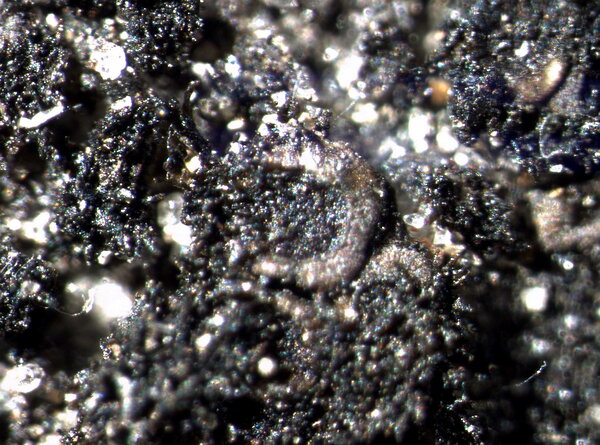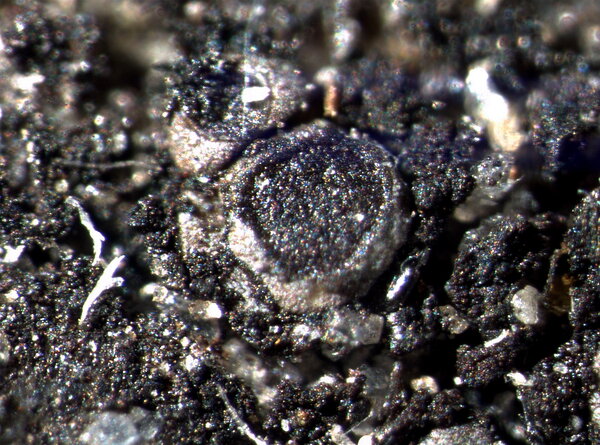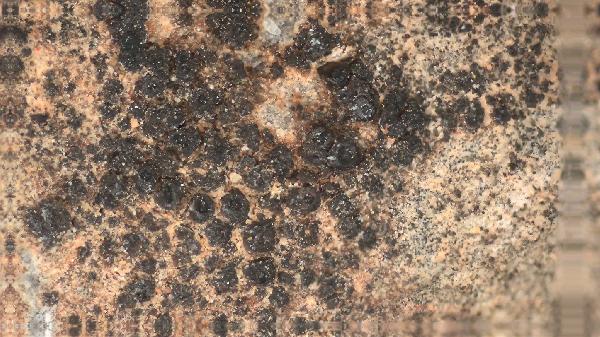Thelignya lignyota (Wahlenb.) P.M. Jørg. & Henssen
in Henssen & Jørgensen, Lichenologist, 22: 145, 1990. Basionym: Verrucaria lignyota Wahlenb. in Ach. - Meth. Lich.: 301, 1803.
Synonyms: Arctoheppia scholanderi (Lynge) Lynge; Porocyphus dispersus E. Dahl; Porocyphus ocellatus (Th. Fr.) Henssen; Psorotichia fuliginea (Ach.) Körb.; Psorotichia lignyota (Wahlenb.) Forssell; Psorotichia ocellata (Th. Fr.) Forssell; Pyrenopsis ocellata Th. Fr.; Thelignya fuliginea (Ach.) A. Massal.
Distribution: C - Sar.
Description: Thallus minutely squamulose to subcrustose, black to very dark olive-brown, dull or slightly glossy, 0.15-0.5 mm thick, consisting of irregularly shaped, (0.3-)0.4-1.5(-2) mm wide, confluent to rarely scattered, flat to uneven squamules with a rough surface, attached to the substrate by a minute, short, irregular stalk or basal gelatinous holdfast, often developing on cyanobacterial patinas. Thallus anatomy more or less paraplectenchymatous, the hyphae with short to slightly elongated cells, roundish to angular, forming an irregular network enclosing the photobiont cells. Apothecia formed from a spheroid tangle of generative hyphae with ascogones and trichogynes (no pycnoascocarps), 1-10 per areole, small, 0.25-0.4(-0.6) mm across, immersed to semi-immersed, with a black, pore-like to slightly expanded and usually soon umbonate disc, and a persistent, (10-)20-35(-50) µm thick, smooth thalline margin. Proper exciple thin, 10-15 µm wide at mid-level, 15-30 µm wide in upper part, colourless to bluish green; epithecium blue-green, K-, N-; hymenium colourless or faintly blue-green in upper part, 65-100 µm high, K/I-, soon with intrusions of agglutinated hyphae forming a central umbo; paraphyses sparse, irregularly branched and anastomosing, the apical cells slightly thickened; hypothecium colourless. Asci 8-spored, narrowly cylindrical-clavate, with a very thin wall disintegrating or opening by apical ruptures, without apical amyloid structures, Lichina-type. Ascospores 1-celled, hyaline, broadly ellipsoid, 7.5-12 x 5.5-9 µm. Pycnidia immersed, simple, globose, c. 50 µm wide, the wall bluish green near the ostiole. Conidia cylindrical to subglobose, 2.5-3.5 x 1.5-2 µm, produced terminally
on simple conidiophores. Photobiont cyanobacterial (Calothrix), filamentous, the tips of filaments tapered, basally often with heterocysts (but filaments often much contorted and split, sometimes better visible towards the base of the squamules), the individual cells 4-9 µm wide. Spot tests: all negative. Chemistry: without lichen substances.
Note: on base- or lime-rich siliceous substrata, periodically submerged in cold creeks, or on otherwise dry surfaces with water seepage after rain; to be looked for also in the Alps.
Growth form: Crustose
Substrata: rocks
Photobiont: cyanobacteria, coccaceous (e.g. Gloeocapsa)
Reproductive strategy: mainly sexual
Periodically submerged (e.g. in creeks)
Commonnes-rarity: (info)
Alpine belt: extremely rare
Subalpine belt: very rare
Oromediterranean belt: very rare
Montane belt: very rare
Submediterranean belt: very rare
Padanian area: absent
Humid submediterranean belt: very rare
Humid mediterranean belt: very rare
Dry mediterranean belt: very rare
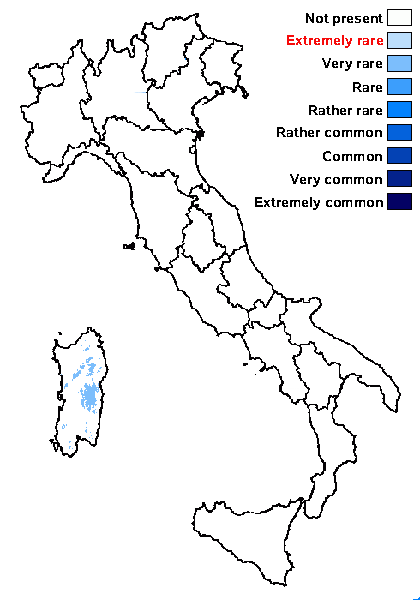
Predictive model
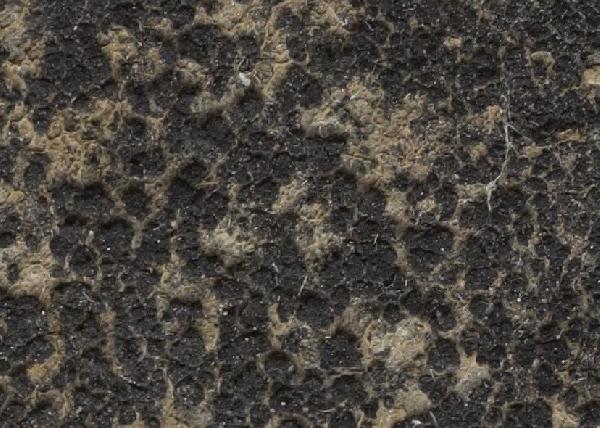
Detail from: https://gzu.jacq.org/GZU000286012
GZU000286012 - Wahlenberg,G. s.n. Date 1802
Location Norway / Finnmark
Label Lichenes Norvegici - Finmark: Altenfjord, Refsbotten.
Annotations Lichenes Norvegici - a Museo Botanico Upsaliensi distributo.
GZU Inv.-Nr. 6.91
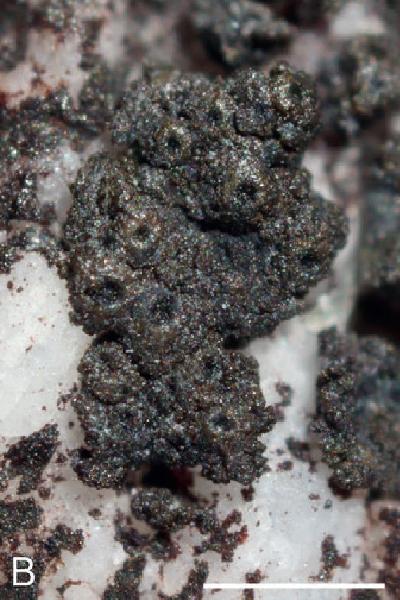
Source: Prieto M., Wedin M., Schultz M. 2024. Phylogeny, evolution and a re-classification of the Lichinomycetes. Studies in Mycology, 109: 595-655. - CC BY-NC-ND
Thelignya lignyota, thallus squamule with numerous
immersed, black apothecia (Schultz 16867). Scale bar: 0.5 mm
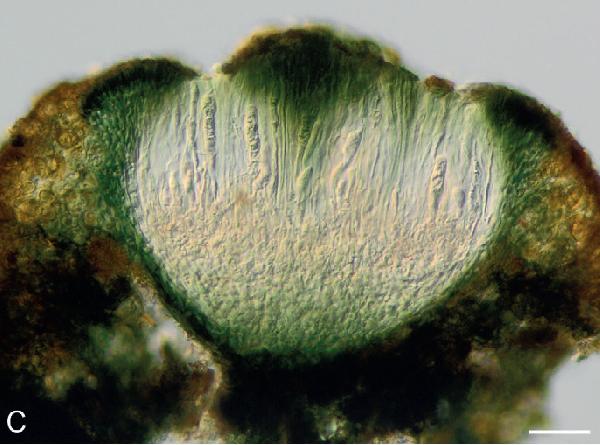
Source: Prieto M., Wedin M., Schultz M. 2024. Phylogeny, evolution and a re-classification of the Lichinomycetes. Studies in Mycology, 109: 595-655. - CC BY-NC-ND
Thelignya lignyota, Apothecium with distinct green colouration of exciple and central umbo (Prieto Pirineos 51). Scale bar: 25 µm
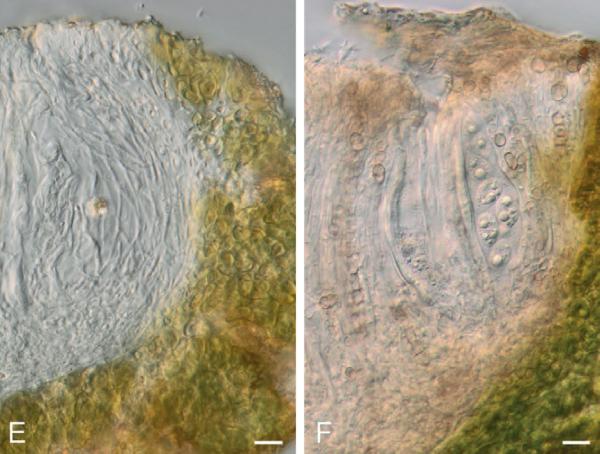
Source: Prieto M., Wedin M., Schultz M. 2024. Phylogeny, evolution and a re-classification of the Lichinomycetes. Studies in Mycology, 109: 595-655. - CC BY-NC-ND
Thelignya lignyota, E. Zeorine apothecial margin, proper
exciple pale, paraphyses lax (Schultz 07226, epitype). F. Ascus with simple ascospores in small hymenial chamber surrounded by robust excipular hyphae,
with unknown lichenicolous fungus (Malíček & Kulíková 7316). Scale bar: 10 µm
Growth form: Crustose
Substrata: rocks
Photobiont: cyanobacteria, coccaceous (e.g. Gloeocapsa)
Reproductive strategy: mainly sexual
Periodically submerged (e.g. in creeks)
Commonnes-rarity: (info)
Alpine belt: extremely rare
Subalpine belt: very rare
Oromediterranean belt: very rare
Montane belt: very rare
Submediterranean belt: very rare
Padanian area: absent
Humid submediterranean belt: very rare
Humid mediterranean belt: very rare
Dry mediterranean belt: very rare

Predictive model

Detail from: https://gzu.jacq.org/GZU000286012
GZU000286012 - Wahlenberg,G. s.n. Date 1802 Location Norway / Finnmark Label Lichenes Norvegici - Finmark: Altenfjord, Refsbotten. Annotations Lichenes Norvegici - a Museo Botanico Upsaliensi distributo. GZU Inv.-Nr. 6.91

Source: Prieto M., Wedin M., Schultz M. 2024. Phylogeny, evolution and a re-classification of the Lichinomycetes. Studies in Mycology, 109: 595-655. - CC BY-NC-ND
Thelignya lignyota, thallus squamule with numerous immersed, black apothecia (Schultz 16867). Scale bar: 0.5 mm

Source: Prieto M., Wedin M., Schultz M. 2024. Phylogeny, evolution and a re-classification of the Lichinomycetes. Studies in Mycology, 109: 595-655. - CC BY-NC-ND
Thelignya lignyota, Apothecium with distinct green colouration of exciple and central umbo (Prieto Pirineos 51). Scale bar: 25 µm

 INDEX FUNGORUM
INDEX FUNGORUM
 GBIF
GBIF



